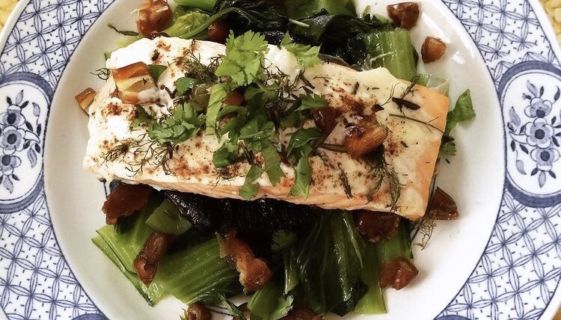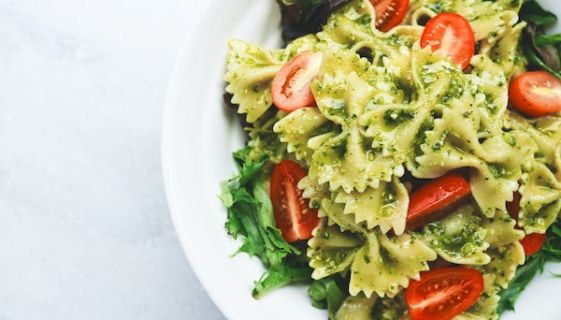As we transition from winter to spring, what our bodies and taste buds crave starts to change, and we are naturally drawn to bright, fresh, vibrant ingredients. During this transitional eating period, it can be difficult to find recipes that feature these lighter ingredients but that are still hearty enough to help us through the last days of winter.
But don’t worry, we have you covered! Our Quinoa and Millet Spring Salad is a delicious dish that can be served either warm (for those still-chilly spring days) or cold. This nourishing recipe checks all the boxes on seasonality, taste, and texture, and includes a delightful array of colors. The hearty nuttiness from the quinoa and millet pairs perfectly with the sweetness from the dates and red onion, a crunch from the almonds, a vibrant freshness from the asparagus and peppers, and a tangy brightness from the citrus, herbs and ginger to balance and enhance this dish’s swirl of flavors.
Ingredients
Dressing
- 1/3 cup mint, chopped
- 1/4 cup parsley, chopped
- 1.5 tsp grated fresh ginger
- 1/4 cup olive oil (you can also use avocado, almond, walnut or flaxseed oil)
- 1 lemon, juiced and zested
- 2 limes, juiced and zested
- 1/2 tsp salt
- Ground black pepper to taste
Quinoa and Millet
- 1/2 cup quinoa
- 1/2 cup millet
- 2 cups water
- 1 tsp olive oil
- 1/2 tsp salt
Salad
- 1 bunch asparagus, cut into 2 inch pieces
- 1 red, yellow and/or orange bell pepper, diced
- 5 pitted dates, diced
- 1/2 red onion, minced
- 1/2 cup almonds, chopped (or nut of choice)
Directions
Dressing
- Combine the dressing ingredients and set aside.
Quinoa and Millet
- Place the quinoa and millet in a bowl with 2 cups of warm water and a tsp of lemon juice or vinegar. Cover and soak overnight.
- After soaking drain grains, discard the soaking water and rinse grains with fresh water.
- Heat a saucepan over medium heat with small amount of olive or avocado oil. Add the millet and quinoa, stirring frequently for 1-2 minutes until it becomes aromatic and grains start to crackle.
- Add 2 cups of water and bring to a boil. Season with salt, reduce to a low simmer, cover and cook grains for about 20 minutes until liquid has been fully absorbed.
- Turn off heat and keep lid on for 5 minutes. After 5 minutes fluff grains with a fork. If you prefer to have a warm salad, keep the grains covered to hold in the warmth. If you prefer to serve the dish at room temperature, uncover the grains and transfer them to a bowl at this point to cool.
Salad
- Heat a large sauté pan over medium heat with a little bit of oil. Add the asparagus and peppers and season with a little salt. Sauté for 5-8 minutes, turning vegetables occasionally. The asparagus will turn a vibrant green and the peppers will begin to soften.
- Place the grains in a large bowl and combine with the asparagus, peppers, dates, red onion and almonds. Toss gently.
- Add dressing and continue tossing gently until fully combined.
- Taste and adjust seasoning.
Nutritional profile
Quinoa and Millet: Provide high amounts of protein for a grain. Packed full of fiber to help promote healthy gut microbes to support a strong immune system and reduce inflammation. They promote satiety and have been linked to increased longevity. The polyphenols in both grains demonstrate high antioxidant activity by employing a chemo-preventive and anti-carcinogenic effect on oxidative stress and free radicals to protect our DNA.
Asparagus: Contains a blend of nutrients to help that help boost energy, cleanse the urinary tract and neutralize excess ammonia in the body. It is high in anti-inflammatory properties from its high amount of antioxidants, including vitamin C, beta-carotene, vitamin E as well as glutathione, which has been shown to slow the aging process and protect our skin from sun damage and pollution.
Bell Peppers: All colors of bell peppers are from the same plant. A bell pepper starts out green and as it ripens will become yellow, orange or red depending on its variety. As the bell pepper ripens there is also an increase in the nutrient concentration, with orange and red having the highest. Bell peppers have high amounts of antioxidants called carotenoids that help protect cells from oxidative damage.
Ginger: Ginger’s bioactive compound 6-gingerol has been shown to have the ability to modulate cellular pathways to active in cancer prevention as well as a potential therapeutic application for treatment. It also improves lipid metabolism, which decreases the risk of cardiovascular disease and diabetes.
Onions: Considered a pre-biotic, meaning it feeds the “good” bacteria in our gut and promotes a healthy digestive system. Research supports that the compounds such as allicin in onions has antioxidant, anti-inflammatory, antimicrobial, and cardioprotective properties
Citrus juice and zest: Packed full of a multitude of nutrients such as vitamin C, flavonoids, and fiber, which aid in vascular protection, reduced inflammation, improved gastrointestinal function and health, and can play an important role in preventing diabetes, cancer, and neurological disease.
Mint and parsley: Contain a range of protective vitamins such as Vitamins A, C, and K, and packed full of antioxidants that help reduce oxidative stress in the body. Such antioxidants are lutein, beta-carotene, and zeaxanthin, which not only are known to reduce the risk of cancer, but also can prevent age-related macular degeneration and support liver health.



 Ananda Kaplan
Ananda Kaplan 

